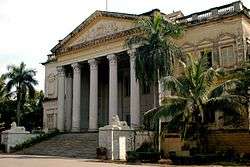British Residency, Hyderabad
| Koti Residency | |
|---|---|
 | |
| General information | |
| Type | Royal mansion |
| Location | Hyderabad, India |
| Completed | Circa 1798 |
Koti Residency or British Residency or "Hyderabad Residency" is an opulent mansion built by James Achilles Kirkpatrick who was British Resident of Hyderabad state between 1798–1805. It is a minor tourist attraction located in the suburb of Koti, Hyderabad.
The villa is in the palladian style and similar in design to its near-contemporary in the United States, the White House. It features in the 2002 William Dalrymple book White Mughals. The house was designed by Lieutenant Samuel Russell of the Madras Engineers and construction began in 1803.
History
Kirkpatrick built the mansion for himself and his Indian wife Khair un Nissa, who bore him two surviving children who were sent to England by the age of five and never saw them again due to the early deaths of their parents.
Koti, meaning a mansion, is a huge mansion built in Palladian Georgian style. The building was at once the embassy of the East India Company to the court of the Nizam of Hyderabad, and the residence of James Kirkpatrick, the British Resident, as well as his successors. Within its compound there were several quarters, including a zenana (women's quarters) where Khair un Nissa lived. Within the compound is a miniature model of the building- legend has it that this was so Kirkpatrick's wife, who remained in purdah, could see the entire mansion, including the front. This scaled model has recently been beautifully restored.
In 1949 it was converted into a women's college, Osmania University College for Women.
After a court directive to the Archaeological Survey of India, it is now a protected monument. However, the building has suffered much damage and part of the ceiling has collapsed.[1]
British Residents at Hyderabad included:
- Major-General William Kirkpatrick (1795-1797) (prior to the residency being built)
- Major James Achilles Kirkpatrick (1797–1805)
- Captain Thomas Sydenham (1806–1810)
- Sir Henry Russell (1811–1820)
- Lord Charles Metcalfe (1820–1825)
- Colonel Cuthbert Davidson (1857–1862)
- Sir Richard Temple (1867–1868)
- C. B. Saunders (1868-1872)
- Sir Richard Meade (1875-1881)
- John Graham Cordery (1883–1888)
- Sir Trevor Chichele Plowden (1891–1900) father of Pamela Plowden, with whom Sir Winston Churchill fell in love while serving in the Army in India in the late 1800s[2].
- Michael O'Dwyer (1908–1909)
- Colonel Alexander Pinhey (1911–1916)
- Sir Stuart Fraser (1916–1919)
- Sir Lennox Russell (1919–1925)
- Sir Duncan Mackenzie (1935–1938)
- Sir Arthur Lothian (1942–1946)
References
| Wikimedia Commons has media related to Koti Residency. |
- ↑ "The British Residency in Hyderabad". Minor Sights. May 2014. Retrieved 23 July 2014.
- ↑ David Smith, "letters Reveal Heartbreak of Young Winston, The Guardian 9 November 2003, https://www.theguardian.com/uk/2003/nov/09/booksnews.redbox; see also Ramachandra Guha, "Churchill in Bangalore," The Hindu Magazine, December 21, 2003 http://www.thehindu.com/thehindu/mag/2003/12/21/stories/2003122100040300.htm
- ↑ http://www.hindu.com/2006/08/31/stories/2006083123110400.htm
https://www.amazon.com/White-Mughals-Betrayal-Eighteenth-Century-India/dp/014200412X